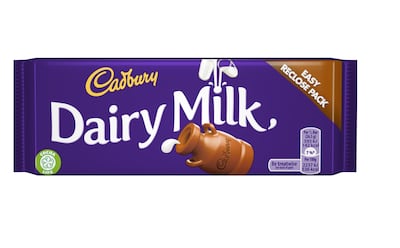Once upon a time, Cadbury used to advertise its milk chocolate with the slogan, “A glass and a half of full-cream milk”. That’s not so common any more, though you will still see a picture of milk being poured from two glasses on the front of the popular bars. The phrase, which was introduced in 1928, referred to the amount of milk used to make half a pound of chocolate, or a box of Milk Tray, once delivered by a black-clad skier.
Now the confectionary says: “The equivalent of 426ml of fresh liquid milk in every 227g of milk chocolate.”
This translates as about two small cups of milk in four standard 55g bars. So there’s milk in Cadbury’s milk chocolate, one of Ireland’s favourite sweets, but what else can you learn from the label?
A note on the front says “Be Treatwise” in tiny writing and “See back of packet” in even tinier text. It also shows there is 150kcal in half a 55g bar and 545kcal in 100g. If Cadbury really wants to be helpful though, it’s odd that it does not say simply say straight out: 300kcal/626kj per bar.
Cadbury developed the "Be Treatwise" label in 2006, according to ConfectionaryNews.com. The idea is to remind people that sweets are "treats to be eaten as part of a balanced lifestyle".
It looks like quite the token effort.
But let’s do as requested and read the back of the packet. The advertising may not have changed much over the years, but the ingredients have, which is hardly surprising given that milk chocolate has been around for nearly 150 years.
The ingredients are: milk, sugar, cocoa butter, cocoa mass, vegetable fats (palm, shea), emulsifiers (E442, E476) and flavourings. (Milk is highlighted in bold because it is a common allergen. The packet also notes there may be some of those other common allergens, nuts or wheat. That will be because products using those ingredients are processed in the same facility.)
It also says “milk solids 20 per cent minimum, actual 23 per cent”. The minimum quoted is to acknowledge that it conforms to EU regulations.
Sugar is the second ingredient and it adds up to half of the finished product, but that will be because there is sugar in the form of lactose in milk too.
Key ingredients
Cocoa butter and cocoa mass are the key ingredients. The butter is the fat extracted from cocoa beans and is the most expensive ingredient in chocolate. The mass is made by grinding roasted beans to make a fine paste. Next up are vegetable fats in palm or shea oil and sadly there is no indication that these cheap oils are from sustainable sources.

E442 is also known as ammonium phosphatide and is used in place of soy lecithin as an emulsifier. It is popular with chocolate companies as it helps to prevent the cocoa butter and powder from separating. E476 is polyglycerol polyricinoleate. It is used to improve flow and means that less cocoa butter can be used. Finally, “flavourings” could refer to any of the thousands of tastes created in laboratories around the world.
Once a small British company, now Cadbury is owned by Mondelez, an American multinational confectionery, food and beverage maker whose other brands include Oreo, Ritz and Philadelphia (as in the cream cheese). It is the second-biggest company of its type in the world and had revenue of almost $7 billion last year. But the chocolate is made in Ireland, where it has a workforce of about 100.
What's missing from the packets is a Fairtrade logo. There is, however, a green symbol in a circle with the words "Cocoa Life" and the website cocoalife.org. This is an organisation set up and run by Mondelez, with a similar stated mission. The question is whether we should trust a multinational to run such an organisation.
You will also notice three circular symbols on one side. The first says “Suitable for vegetarians” which is self-explanatory. The next looks like a white arrow chasing a black one or vice versa, in a kind of whirlpool. You could be forgiven for thinking that this means that the packaging is recyclable. But it doesn’t. This symbol indicates that the producer has made a financial contribution towards the recovery and recycling of packaging. It has a tiny “r” inside a circle next to it to indicate that this is a registered trade mark.
So don’t throw the wrapper in the recycle bin. Follow the little man in the third symbol who can be seen pitching something into a waste paper basket. That pictogram is there to remind you to put your rubbish in the bin.
No more, no less.
FOOD LABELS SERIES
1) Being a successful shopper
2) Bread
3) Milk
4) Cereal
5) Rashers
6) Yoghurt
7) Soup
8) Hummus
9) Pasta sauce
10) Chinese ready meals
11) Frozen chips
12) Chilled fish
13) Egg
14) Chicken Kiev
15) Crisps
16) Mayonnaise
17) Baked beans
18) Tomato ketchup
19) Chocolate digestive biscuits
20) Avocados











